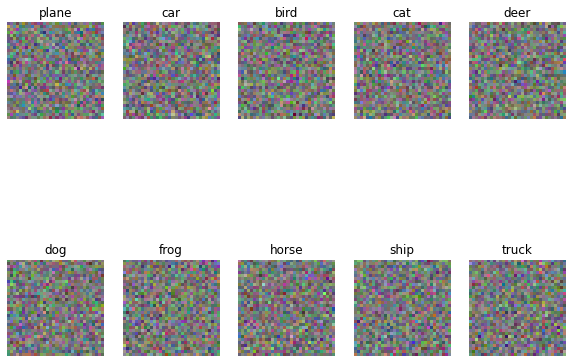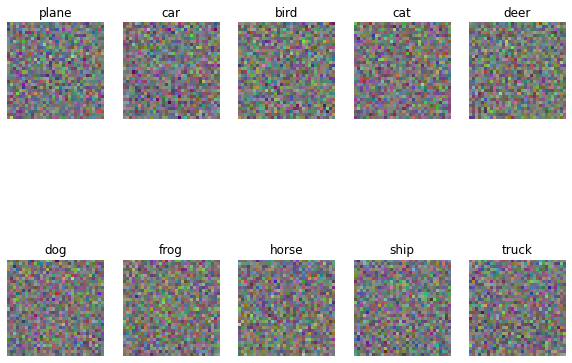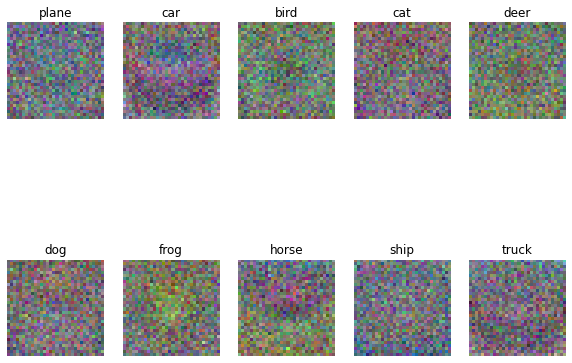- -为Softmax分类器实现完全矢量化的损失函数
- -实现解析梯度完全矢量化的表达式
- 使用数值梯度检查实现结果
- 使用验证集调整学习率和正则化强度
- 使用SGD优化损失函数
- 可视化最终学习的权重
softmax.ipynb
库、绘图设置和数据的导入和SVM一样
Train data shape: (49000, 3073) Train labels shape: (49000,) Validation data shape: (1000, 3073) Validation labels shape: (1000,) Test data shape: (1000, 3073) Test labels shape: (1000,) dev data shape: (500, 3073) dev labels shape: (500,)
Softmax Classifier
`cs231n/classifiers/softmax.py`
首先完成带嵌套循环的softmax_loss_naive
def softmax_loss_naive(W, X, y, reg):
# Initialize the loss and gradient to zero.
loss = 0.0
dW = np.zeros_like(W) #创建一个与W具有相同形状的全零数组。
N = X.shape[0]
for i in range(N):
score = X[i].dot(W) #长度为C?
exp_score = np.exp(score - np.max(score)) #防止溢出
loss += -np.log(exp_score[y[i]]/np.sum(exp_score)) / N #复刻公式
#loss += (-np.log(exp_score[y[i]])+ np.log(np.sum(exp_score))) / N #展开
dexp_score = np.zeros_like(exp_score)
dexp_score[y[i]] -= 1/exp_score[y[i]]/N
dexp_score += 1 /np.sum(exp_score) / N
dscore = dexp_score *exp_score
dW += X[[i]].T.dot([dscore])
loss +=reg*np.sum(W**2)
dW += 2*reg*W
# *****END OF YOUR CODE (DO NOT DELETE/MODIFY THIS LINE)*****
return loss, dW
注意使用exp避免数值溢出之后要用本地梯度乘上游梯度得到梯度值。
向量化的softmax_loss_vectorized
def softmax_loss_vectorized(W, X, y, reg):
# Initialize the loss and gradient to zero.
loss = 0.0
dW = np.zeros_like(W)
#
scores = X.dot(W)
#exp_score = np.exp(score - np.max(score))
scores -= np.max(scores, axis=1, keepdims=True)#保持dim
exp_scores = np.exp(scores)
probs = exp_scores / np.sum(exp_scores, axis=1, keepdims=True)
# Compute the loss
N = X.shape[0] #有点不熟悉这个维度012的顺序
loss = np.sum(-np.log(probs[np.arange(N), y])) / N
loss += reg * np.sum(W * W) #正则化强度的系数其实无所谓?只要不太小应该效果都差不多
# Compute the gradient
dscores = probs
dscores[np.arange(N), y] -= 1
dscores /= N
dW = X.T.dot(dscores)
dW += reg * W
return loss, dW
超参数调试
# Use the validation set to tune hyperparameters (regularization strength and
# learning rate). You should experiment with different ranges for the learning
# rates and regularization strengths; if you are careful you should be able to
# get a classification accuracy of over 0.35 on the validation set.
from cs231n.classifiers import Softmax
results = {}
best_val = -1
best_softmax = None
################################################################################
# TODO: #
# Use the validation set to set the learning rate and regularization strength. #
# This should be identical to the validation that you did for the SVM; save #
# the best trained softmax classifer in best_softmax. #
################################################################################
# Provided as a reference. You may or may not want to change these hyperparameters
learning_rates = [3e-7,4e-7,5e-7]
regularization_strengths = [0.5e4, 1e4,1.5e4,2e4]
# *****START OF YOUR CODE (DO NOT DELETE/MODIFY THIS LINE)*****
# Iterate over all hyperparameter combinations
for lr in learning_rates:
for reg in regularization_strengths:
# Create a new Softmax classifier
softmax = Softmax()
# Train the classifier on the training set
softmax.train(X_train, y_train, learning_rate=lr, reg=reg, num_iters=1000)
# Evaluate the classifier on the training and validation sets
train_accuracy = np.mean(softmax.predict(X_train) == y_train)
val_accuracy = np.mean(softmax.predict(X_val) == y_val)
# Save the results for this hyperparameter combination
results[(lr, reg)] = (train_accuracy, val_accuracy)
# Update the best validation accuracy and best classifier
if val_accuracy > best_val:
best_val = val_accuracy
best_softmax = softmax
# *****END OF YOUR CODE (DO NOT DELETE/MODIFY THIS LINE)*****
# Print out results.
for lr, reg in sorted(results):
train_accuracy, val_accuracy = results[(lr, reg)]
print('lr %e reg %e train accuracy: %f val accuracy: %f' % (
lr, reg, train_accuracy, val_accuracy))
print('best validation accuracy achieved during cross-validation: %f' % best_val)
目前调出来比较好一点的是
lr 5.000000e-07 reg 5.000000e+03 train accuracy: 0.386000 val accuracy: 0.392000
最后看看在test上的准确率
# evaluate on test set
# Evaluate the best softmax on test set
y_test_pred = best_softmax.predict(X_test)
test_accuracy = np.mean(y_test == y_test_pred)
print('softmax on raw pixels final test set accuracy: %f' % (test_accuracy, ))
softmax on raw pixels final test set accuracy: 0.384000
对比一下不同步数的权重图像差异
|
|
|
|
| 100 | 500 | 1000 |
|
|
|
|
| 1500 | 3000 | 5000 |
(多整了一些)噪点的减少还是非常明显的,虽然1500之后准确率没太大区别





